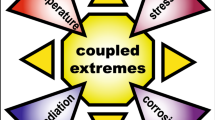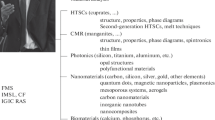Abstract
Chemomechanics of materials is an exciting and fast growing field where mechanics meets chemistry. This perspective presents a brief overview of recent advance in the study of materials chemomechanics. We identify challenges and opportunities for tackling the long-standing and emerging problems for the field.
Similar content being viewed by others
References
Cottrell A H, Bilby B A. Dislocation theory of yielding and strain ageing of iron. Proc Phys Soc A, 1949, 62: 49–62
Rice J R. Thermodynamics of the quasi-static growth of Griffith cracks. J Mech Phys Solids, 1978, 26: 61–78
Lawn B. Fracture of Brittle Solids. Cambridge: Cambridge University Press, 1993
Michalske T A, Freiman S W. A molecular interpretation of stress corrosion in silica. Nature, 1982, 295: 511–512
Rice J R. Hydrogen and interfacial cohesion. In: Thompson A W, Bernstein I M, eds. Effect of Hydrogen on Behavior of Materials. New York: Metallurgical Society of AIME, 1976. 455–466
Argon A S. Strengthening Mechanisms in Crystal Plasticity. New York: Oxford Unversity Press, 2008
Cabrera N, Mott N F. Theory of the oxidation of metals. Rep Prog Phys, 1948, 12: 163–184
Mott N F, Rigo S, Rochet F, et al. Oxidation of silicon. Philos Mag B, 1989, 60: 189–212
Pastewka L, Moser S, Gumbsch P, et al. Anisotropic mechanical amorphization drives wear in diamond. Nat Mater, 2011, 10: 34–38
Zhu T, Li J. Ultra-strength materials. Prog Mater Sci, 2010, 55: 710–757
Tarascon J M, Armand M. Issues and challenges facing rechargeable lithium batteries. Nature, 2001, 414: 359–367
Rogers J A, Someya T, Huang Y. Materials and mechanics for stretchable electronics. Science, 2010, 327: 1603–1607
Dong X, Fang X, Feng X, et al. Diffusion and stress coupling effect during oxidation at high temperature. J Am Ceram Soc, 2013, 96: 44–46
McDowell M T, Lee S W, Nix W D, et al. 25th anniversary article: Understanding the lithiation of silicon and other alloying anodes for lithium-ion batteries. Adv Mater, 2013, 25: 4966–4985
Suo Z. Mechanics of stretchable electronics and soft machines. MRS Bull, 2012, 37: 218–225
Huang J Y, Zhong L, Wang C M, et al. In situ observation of the electrochemical lithiation of a single SnO2 nanowire electrode. Science, 2010, 330: 1515–1520
Liu X H, Liu Y, Kushima A, et al. In situ TEM experiments of electrochemical lithiation and delithiation of individual nanostructures. Adv Energy Mater, 2012, 2: 722–741
McDowell M T, Xia S, Zhu T. The mechanics oflarge-volume-change transformations in high-capacity battery materials. Extreme Mech Lett, 2016, 9: 480–494
Zhang S, Zhao K, Zhu T, et al. Electrochemomechanical degradation of high-capacity battery electrode materials. Prog Mater Sci, 2017, 89: 479–521
Liu X H, Zheng H, Zhong L, et al. Anisotropic swelling and fracture of silicon nanowires during lithiation. Nano Lett, 2011, 11: 3312–3318
Liu X H, Zhong L, Huang S, et al. Size-dependent fracture of silicon nanoparticles during lithiation. ACS Nano, 2012, 6: 1522–1531
Wang J W, He Y, Fan F, et al. Two-phase electrochemical lithiation in amorphous silicon. Nano Lett, 2013, 13: 709–715
Yu Q, Qi L, Tsuru T, et al. Origin of dramatic oxygen solute strengthening effect in titanium. Science, 2015, 347: 635–639
Li Y, Fang X, Qu Z, et al. In situ full-field measurement of surface oxidation on Ni-based alloy using high temperature scanning probe microscopy. Sci Rep, 2018, 8: 6684
Hao F, Gao X, Fang D. Diffusion-induced stresses of electrode nanomaterials in lithium-ion battery: The effects ofsurface stress. J Appl Phys, 2012, 112: 103507
Yu P, Shen S. A fully coupled theory and variational principle for thermal-electrical-chemical-mechanical processes. J Appl Mech, 2014, 81: 111005
Wang F, Turcheniuk K, Wang B, et al. Mechanisms of transformation of bulk aluminum-lithium alloys to aluminum metal-organic nanowires. J Am Chem Soc, 2018, 140: 12493–12500
Hong W, Zhao X, Zhou J, et al. A theory of coupled diffusion and large deformation in polymeric gels. J Mech Phys Solids, 2008, 56: 1779–1793
Zhao K, Pharr M, Cai S, et al. Large plastic deformation in high-capacity lithium-ion batteries caused by charge and discharge. J Am Ceram Soc, 2011, 94: s226–s235
Keralavarma S M, Bower A F, Curtin W A. Quantum-to-continuum prediction of ductility loss in aluminium-magnesium alloys due to dynamic strain aging. Nat Commun, 2014, 5: 4604
Nalla R K, Kinney J H, Ritchie R O. Mechanistic fracture criteria for the failure of human cortical bone. Nat Mater, 2003, 2: 164–168
Gao H. Probing mechanical principles of cell-nanomaterial interactions. J Mech Phys Solids, 2014, 62: 312–339
Author information
Authors and Affiliations
Corresponding author
Rights and permissions
About this article
Cite this article
Zhu, T., Fang, X., Wang, B. et al. Challenges and opportunities in chemomechanics of materials: A perspective. Sci. China Technol. Sci. 62, 1385–1387 (2019). https://doi.org/10.1007/s11431-018-9516-2
Received:
Accepted:
Published:
Issue Date:
DOI: https://doi.org/10.1007/s11431-018-9516-2




